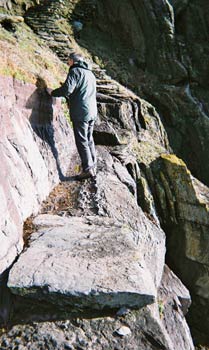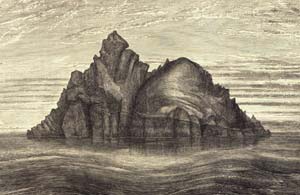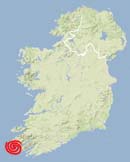22 Nov Skellig Michael
“The most fantastic and impossible rock in the world: Skellig Michael…where in south west gales the spray knocks stones out of the lighthouse keeper’s house…the Skelligs are pinnacled, crocketed, spired, arched, caverned, minaretted; and these gothic extravagances are not curiosities of the islands: they are the islands: there is nothing else. The rest of the cathedral may be under the sea for all I know…An incredible, impossible, mad place…I tell you the thing does not belong to any world that you and I have lived and worked in: it is part of our dream world.”
George Bernard Shaw, 19101
“Skellig has authority. The monks who went to live there knew that what they did was the most you could say about belief without actually slitting your own or someone else’s throat.”
Judy Kravis, 19962
Drag within the image to explore the monastic settlement at Skellig Michael in virtual reality.
A Visit to the Island
It is not easy to visit Skellig Michael (St. Michael’s Rock). The taller of its twin peaks thrusts abruptly 218 m (715 ft) from the sea 11.6 km (7.2 m) off the westernmost tip of Co. Kerry’s Iveragh Peninsula. A trip to the island’s monastic site is an experience which, in Peter Harbison’s words, “the expectation aroused by photographs and oral accounts is not only not disappointed but is actually far surpassed.”3
While today’s visitors need not suffer through the four-hour wave-tossed ordeal of a 19th-century traveler,4 even on the most modern tourist boats the demand for Dramamine can quickly exceed the supply.5 The sealife-encrusted metal ladder needed to board the ship at low water in Portmagee presents a challenge, but not nearly so much as disembarking at the bare-bones landing at Great Skellig, synchronizing your step over the side with the surge rocking the boat. On some days tourists intending to land will find that conditions have deteriorated by the time of their arrival and, after an unsettling cruise around the Little and the Great Skelligs, they find themselves returning to the mainland without disembarking on the island. Here there are no guarantees.
In the virtual-reality tour (above) the initial view of the island from the sea is adapted from a photograph by Jerzy Strzelecki. A hotspot will lead to a 360° panorama of the monastic enclosure.
The monks who, as early as the sixth century, created their remote refuge from the world, built three different boat landings. At each landing they constructed a long winding stone stairway leading up to the monastic site later dedicated to St. Michael, the patron saint of high places. Their refuge was built near the top of the northern summit, 166 m (545 ft) above the waves. Their intimate knowledge of wind and tide would guide them to the best haven for their currachs any given day, although some winter months may have allowed no landing at all.
Today only the 618 steps of the southern stairway, ascending more than 180 m (600 ft), are maintained and accessible to visitors. These steps however are “maintained” only in the sense that stones are put back in place as required. There is no mortar holding the thousand-year-old staircase together; and the individual steps, made of irregular and roughly hewn stones, have no standard measurement for their risers or treads. Thus each step is subtly different from the previous and the next. The stairs are slippery when wet, and it rains regularly.
In the spring of 1851, antiquarian author John Windele made the arduous trip to the island and wrote of his climb up to the monastic enclosure. The experience will be similar today:
“[The stairway] winds on the external face of the precipice with no protection at the outer side, the sheer wall like a rock at the inner. It was by no means a comfortable ascent for me…
I gradually became alarmed and nervous as I looked down upon the vast and frightful depths below and the total want of protection, and I found my best course was to shut out the view in that quarter by closing my seaward eye and looking only at the rock [to the] inside…and the steps before [me].
…
The descent was far from agreeable. It was only then that the vast elevation above the sea and the almost vertical character of the precipice along the face of which wound the narrow stairs presented themselves in all their appalling reality. A few steps downward even with face averted from the chasm to the left only increased a tendency to dizziness. For safety I quitted my upright position and made the remainder of my way in a seated posture—an inglorious spectacle…” 6
The photograph to the right gives a sense of the most precarious section of the stairway. There are many places where a stumble invites injury, but in a few spots a momentary bout of vertigo can be deadly. In two separate fatal accidents in 2009, visitors lost their footing and plunged to their deaths.7 A subsequent safety review concluded, for various reasons, that no handrails would be installed.8 Yet each day the weather cooperates during the mid-May through late-September season up to 180 stalwart visitors make this pilgrimage on one of the accredited Skellig ferries.
Nature Reserves
Skellig Michael not only contains “the most spectacularly situated of all the early medieval island monastic sites,9 but also the remnants of an even more remote and inaccessible hermitage high up on the south peak. Furthermore the island is an important breeding site for seabirds such as Fulmar, Kittiwake, Storm Petrel, Manx Shearwater, and Puffin (see photograph, below left). On uninhabited Little Skellig, 1 km (.62 m) to the northeast, the colony of Northern Gannets includes more than 23,000 nesting pairs, one of the largest gannet colonies in the world. Scuba divers sometimes share boat rides with other visitors to explore the clear waters off the island and observe the seals close up. While today both of the Skelligs are protected Nature Reserves, in earlier times local boatmen hunted the birds on the island, as did the monks many centuries before them. John Windele describes the technique used in 1851 to capture birds on Skellig Michael:
“Our attention was speedily directed to a fellow quietly seated about 150 feet below us on the narrowest possible ledge of rock…Occasionally he extended downward a long pole, at the extremity of which was a noose which with strange dexterity he placed upon the neck of an unsuspecting bird; and without creating the slightest commotion he drew it up flapping its wings and after probably giving it a coup de grace he in a very business-like way deposited it in a bag slung from his shoulders.” 10
Monastic Site Satellite View. Expand.
Early History and Prehistory
While it is possible that a monastery was established here as early as the sixth century, precise dating is difficult. The first written evidence of Skellig Michael is found in a late eight-century account of the death of a monk from the island. The ninth-century predations of the Norse marauders are noted in other sources. By the 10th century the monastery had been dedicated to St. Michael, with the structure known as St. Michael’s Church architecturally dated to this period.11 There is no further mention of the settlement in the historical record between 1044 and the first modern account of the island, Charles Smith’s 1756 Ancient and Present State of the County of Kerry.
In legend, however, the story of the Skelligs goes back much farther than the sixth century. According to the 11th-century Lebor Gabála Érenn (Book of Invasions) Milesius, a leader of one of the prehistoric invasions of Ireland, lost two of his sons nearby in 1400 BCE when a magical storm invoked by the Tuatha de Danann caused a shipwreck. One of his sons, Donn, may have been commemorated in a now lost upright slab located at the end of a treacherous rock spit previously visited by pilgrims (see below).
“The stout Amergin, was in battle slain,
Irr lost his life upon the western main;
Skelig’s high cliffs the hero’s bones contain.
In the same wreck Arranan too was lost,
Nor did his corps e’er touch lerne’s coast.” 12
Another casualty of the Milesian invasion force is commemorated at the nearby Baslicon Dolmen outside Waterville.
In the Fenian tales it is recounted that c. 200 CE the “King of the World” Daire Domhain spent time on Skellig Michael prior to his year-and-a-day battle at Ventry with Fionn Mac Cumhaill. Another legend tells how, in the fifth century, Duagh, the King of Íarmumu (West Munster), found refuge in the Skelligs while being pursued by the King of Cashel.13
The Monastery
“The scene is one so solemn and so sad that none should enter here but the pilgrim and the penitent. The sense of solitude, the vast heaven above and the sublime monotonous motion of the sea beneath would oppress the spirit, were not that spirit brought into harmony…”
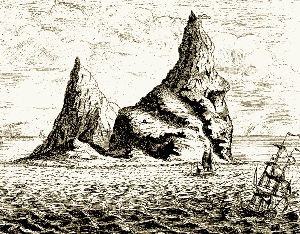
While it is unlikely that Charles Smith ever set foot on Skellig Michael (as his fanciful 1756 drawing would suggest), his account of the Island’s pilgrimage tradition has been confirmed by other sources.
Lord Dunraven, 1875 14
Early Irish monks, wishing to emulate the sacrifice and pure withdrawal into a life of faith exemplified by St. Anthony going out into the desert, found a parallel experience—the remote and deserted Irish offshore islands. The monastic ideal was to demonstrate an intense devotion by such extreme acts of self-exile: peregrinatio pro Dei amore, “pilgrimage for the love of God.”15 Here, the love of God was brought to a new level, as no other Irish monastery was built in such a challenging location.
The establishment of the monastic settlement on Great Skellig is, according to local lore, credited to the sixth-century St. Fionán, a significant South Kerry saint who founded Innisfallen Abbey. The site drew its support from the local Corcu Duibne (Kingdom of Kerry) dynasties.16
In the ninth century the idyllic but challenging life on the remote monastery was made even more challenging by the rampaging Vikings, who may have believed that the rocky refuge held either valuable objects to pillage or important men to be held for ransom.
“[In 824] Scelec was plundered by the heathens and Étgal was carried off into captivity, and he died of hunger on their hands.
…
There came a fleet from Luimnech [Limerick, founded by the Norsemen] in the south of Erinn, they plundered Skellig Michael, and Inishfallen and Disert Donnain and Cluain Mor, and they killed Rudgaile, son of Selbach, the anchorite. It was he whom the angel set loose twice, and the foreigners bound him twice each time.” 17
The reputation of the Norse invaders likely preceded them to the monastic island. Their terrifying habit of burning villages and slaughtering the inhabitants included, according to some sources, the horrific practice of the “tossing of infants on top of their lances to and from each other.”18 The different flights of steps on three sides of the island, while providing the monks the convenience of landing their boats in different seas, also gave the invading Vikings the means to attack the monastic site from different sides simultaneously. It may be that the extremely difficult-to-access remote hermitage on the South Peak (below) became the sanctuary of last resort.
In an ironic and likely apocryphal local legend it is told that in 993 Viking Olaf Trygvasson, later to become Olaf I, King of Norway, was intent on a raid of the monastery but instead was baptized into the Christian faith by a Skellig hermit. His son, Olaf II, became the patron saint of Norway.19
By the 13th century Irish Christianity was transforming itself from the Celtic Church’s monastic model to the diocesan structure of the Anglo-Normans. This political change, as well as colder weather and greater winter storm activity, forced the monks (by now Augustinians) to abandon the island and recreate their monastery on the mainland at Ballinskelligs Bay, near Waterville.20
While the medieval move to the mainland put an end to perhaps 600 years of year-round monastic life on Skellig Michael, it also marked the beginning of a long enduring tradition of lay pilgrimage to the abandoned monastery.21 This was to evolve into an experience, which included—for some pilgrims— astonishing physical peril (see below).
The Ballinskelligs Augustinians continued to control the island monastery until 1578, when Queen Elizabeth reacted to the Desmond Rebellion by dissolving some of the monasteries aligned with that family. The Butler family acquired the Skellig islands, now secularized. However, pilgrims and penitents continued to offer up the arduous visit to Skellig Michael.
In the 1820s the government purchased the islands to build lighthouses for the safety of passing ships.22 The builders found temporary housing in the stone huts of the monastery. Finally, in 1880 the Office of Public Works assumed guardianship of the monastic remains and ultimately most of the island’s acreage.
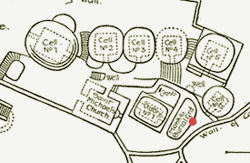
This plan was made by J.R. Allen in 1881 from Lord Dunraven’s c. 1868 drawing. The red dot indicates the viewpoint of the VR panorama.
The Monastic Remains
The remarkably preserved monastic enclosure of Skellig Michael sits 15 m (50 ft) below the northern peak on a long narrow terrace, enclosed by a drystone wall. The site faces south, usually sheltered from the prevailing winds. One end of the terrace, a bit lower and divided by a partition, may have been used for cultivation23 and is known as the Monks’ Garden. Above this and across the wall is an entrance and steps up to the larger enclosure, the main monastic area where the six beehive huts, the early boat-shaped oratory, and the medieval St. Michael’s Church are located. Other raised platforms contain incised crosses and cross-slabs, as well as a cemetery with 22 early grave slabs. Another, smaller oratory of later date stands on a northeastern shelf above the cliffs, with the boat landing far below. Close to this lie the remains of a beehive toilet cell, a structure not found in other monastic sites from this era (though some consider it a modern construction).
All the early structures are of dry-stone corbelled construction. Interestingly, while the monks’ cells are rounded from the outside their interior spaces are quadrangular and floored with squared slabs. It is conjectured that the stones projecting out from the exterior faces of the huts (seen in VR tour) serve as structural balances. Both of the boat-shaped oratories are similar to the classic shape of that at Gallarus but are not as smoothly finished. The larger oratory, internally about 2.3 m (7.5 ft) high, has a white quartz cross, a later addition, set into the stones above the door on the outside. The largest of the beehive huts, “Cell 1” in the diagram (above, left), is thought to have had a communal purpose as it is more sturdily built, 5 m (16.4 ft) high, with walls 1.8m (6 ft) thick at its base, with two cupboards and a double-lintelled door.24
St. Michael’s Church, the only mortared structure in the enclosure, ironically was the one found partly collapsed in the late 19th century when a retaining wall failed. Unlike the cells or oratories, the church is rectangular, with straight walls and sharp corners. It once had a timber roof. It was likely constructed in two distinct stages, with an earlier, smaller, structure incorporated into the church as seen today. In its center is a late-19th-century gravestone that mentions the lighthouse families of 1868.
Archaeologists believe that no more than a dozen monks and an abbot lived out their ascetic lives on their aerial refuge from the secular world. Excavations in the main monastic area have yielded the remains of at least eight individuals, all either adult males or children between the ages of nine and eleven. Dated from between the 10th and the 13th centuries, these bones were not recovered from the cemetery area but rather from locations near the outside walls of the structures.25
The Pilgrimage and the Hermitage on the South Peak
“If the reader can conceive a person, poised as it were, or rather perched, on the summit of this pinnacle, beholding the vast expanse of the ocean all around him, except towards the East, where the lofty mountains on the shore appear like so many low houses, overlooked from the lofty dome of some cathedral, he may be able to form some idea of the tremendousness, and awfulness of such a prospect.”
Charles Smith, Ancient and Present State of the County of Kerry, 175626
From the dividing point at Christ’s Valley, The South Peak of Skellig Michael rises 20 m (65 ft) above the North Peak, the site of the monastic settlement. For hundreds of years, until the early 20th century, the South Peak was the focus of the Skellig Michael pilgrimage. In the 16th century this pilgrimage was listed as one of the most important penitential stations for public contrition. One man was obliged to undertake the challenge as a penance for murdering his own son.27 Navigating these challenging “stations,” the fearless penitent would first wedge himself up through the Needle’s Eye, a stone chimney some 150 m (490 ft) above the sea requiring a gymnast’s agility to negotiate. After passing along the tribulations of the narrow Stone of Pain, he would ultimately edge himself out astride an even thinner precipice called the Spit, 3 m (10 ft) long and in parts only 20 cm (8 in) wide, with the goal of kissing the cross-etched slab at its extremity.28
Although earlier observers of the pilgrimage noted what seemed to be artificial ledges and stairways on its route leading up to the summit, it wasn’t until 1990 that researchers, after removing the covering vegetation, determined that the South Peak was once the site of a remote hermitage, with three distinct terraces, likely dating from the ninth century.29 The researchers named them the Garden Terrace, the Oratory Terrace, and the Outer Terrace. As this site surpasses the monastic site in its height, it once exceeded it in its expression of piety, as we can imagine individual monks leaving the monastery to climb to this barely accessible hermitage for solitary prayer and penance.
“[This is] the more treacherous peak of the island, once conquered by men who searched fearlessly for ways to reach God…the remains of one of the most daring architectural expressions of early Irish monasticism: a hermitage built virtually in the air on the treacherous ledges of an Atlantic rock rising straight up from the ocean to an altitude of 218 meters [715 ft]…Once a monastery had been founded, the only place of retreat left on the island for a man who desired to come closer to God was an even higher and less accessible spot, the South Peak.” 30
The monks who created this refuge-from-a-refuge found no level surfaces on which to build their hermitic oratories. They were obliged to create building platforms themselves, by erecting walls at the edges of steep ledges, “along the very boundary between life and death.”31 Within the Oratory Terrace, near the remains of an altar, are two small rock-cut basins intended to hold water, one flowing into the other, both filled from channels cut into the nearly vertical exposed rock faces above.
The discovery and documentation of the Forgotten Hermitage of Skellig Michael, undertaken during six seasons of summer fieldwork beginning in 1981, is as grand an adventure as an art historian and an architect have ever recounted. Not told at the plodding pace of some archaeological tomes, Walter Horn, Jenny White Marshall, and Grellan D. Rourke present an engaging account of adventure and discovery. The work—and its documentation—demanded death-defying mountaineering skills as well as methodical planning. The publication is available in its entirety online, along with all its illustrations.
Horn, Marshall, and Rourke did more, however, than just discover and document the “forgotten hermitage.” And that is where a controversy has developed in some circles, or perhaps fringes, of Irish archaeology. Grellan Rourke, a Senior Conservation Architect employed by the National Monuments Service who has overseen the work on Skellig Michael for 30 years, was tasked with limited rescue and restoration work where necessary to ensure the structural integrity of the monastic remains. He and his workers, for example, shored up the retaining walls where their collapse threatened the stability of St. Michael’s Church.
Similar work was undertaken, with great difficulty due to the perilous terrain, at one of the terraces of the South Peak’s hermitage.32 This work aroused the ire of Michael Gibbons, a former coordinator of the OPW’s Sites and Monuments Records Office. In 2007 he very publically charged Rourke’s team with making errors of interpretation and conspiring to cover up their mistakes. Not only did Gibbons and his supporters go to the popular press with the complaints and create an emotional YouTube video, they also brought their concerns to UNESCO, and thus potentially put at risk the listing (since 1996) of the island as a World Heritage Site. Skellig Michael, along with Co. Meath’s Newgrange passage tomb, are the only two such listed sites in Ireland.33
Such professional squabbles regarding archaeological restorations were more frequent in the 19th and early 20th centuries, such as complaints regarding the work on Dun Aengus, the Iron Age fort on Inishmore in the Aran Islands, and on the monastic enclosure on Inishmurray. In 1892 a writer noted of the Board of Works restorations on Skellig Michael that,
“An ordinary mason was seen calmly tinkering away at the ruins, pulling down a bit here and building up a bit there in imitation of the old style of work, without any kind of superintendence whatever. The vandalism perpetrated some time ago by the same authorities, at Inismurray [sic], is being repeated here with a vengeance.” 34
Gibbons, among his other concerns, noted that “19th-century layers and structural elements were removed.”35 To an outside observer, it may be unclear how an ill-conceived restoration of the 1890s, or the earlier ad hoc constructions of the lighthouse workers, could become a century later cultural artifacts worthy of protection even to the peril of the original monastic remains. He also claims to have identified vestiges of other stairways not noted by Rourke’s survey.
To this criticism, Rourke, together with National Monuments Service Senior Archaeologist Dr. Ann Lynch, responded:
“Preservation of the monastic structures for future generations has been the underlying philosophy. Interventions have been necessary, but preservation of original material has been paramount and has been the guiding influence at all times….Work has commenced on a publication that will detail the engineering, architectural and archaeological works undertaken and will attempt to put this unique site into historical context.” 36

After generations of protection from hunting, puffins allow visitors a close approach. The birds are usually present from April until mid-August. There may be as many as 6,000 individuals some seasons.
In 2007 UNESCO representatives visited the site and determined that while the conservation work was necessary, further documentation of its scope was required. The body also suggested that OPW ought to have engaged other archaeologists in the discussion before proceeding with the restoration. A panel of Irish scholars, independent of OPW, is now tasked with overseeing such work.37
Island Folklore
“One of the old legends connected with the Skelligs is, that every madman, if left to himself, would immediately direct his course thither.” (Lady Chatterton, Rambles in the South of Ireland During the Year 183838)
For all the centuries of Christian monasticism and pilgrimage associated with Skellig Michael, there is relatively scant evidence of pagan ritual or local folklore connected with the island. John Windele, visiting in 1851, entertained the notion that St. Michael’s Church, dedicated to the celebrated dragon-slaying saint, occupied the location of “some ancient object of pagan superstition, probably a dracontium [serpent temple]…39
In his 12-century Topography of Ireland, Giraldus Cambrensis wrote an entry entitled “Of the Stone in which a Cavity is Every Day Miraculously Filled with Wine.”
“There is an island with a church dedicated to St. Michael, famed for its orthodox sanctity from very ancient times. There is a stone outside the porch of this church, on the right hand, and party fixed in the wall, with a hollow in its surface, which, every morning, through the merits of the saint to whom the church is dedicated, is filled with as much wine as will conveniently suffice for the service of the masses on the day ensuing, according to the number of the priests there who have to celebrate them.” 40
Another bit of local lore that refers obliquely to the sanctity of the site insists that a seabird is unable to take flight from the monastic enclosure on the island; some unseen force is said to require the creature to walk through the monastic property before again becoming airborne. As quoted by Lord Dunraven in 1875:
“There is no bird that threds [makes his way] in the said churchyeard above but must go to the very brinke or bancke thereof affore they can fly; they can fly over it, but if they light in that place they can never fly until they run to the brink as afforesaide. Lett no man doubt of this, for it is as sure as death, and the place is held miraculous out of those workes…” 41
Peig Sayers, in her 1938 book of stories from the Blasket Islands, Scealta on mBlascaod, tells of Ana Ní Áine, the Old Woman of Kenmare (here translated by Skellig guide and author Des Lavelle):
“We set out for Skellig but before we reached the island a dreadful darkness approached from the West…The dark cloud steadily approached with great gusts of wind. The priest looked towards it. ‘There is some mystery in that cloud’, he said.
It was now bearing down on us until it was almost upon the boat, and then we could see that within the cloud was the spirit of a woman! The priest jumped to his feet, put his confessional stole around his neck and took his book in his hands. He spoke to the woman and asked her what caused her unrest.
“I killed a person,” said the woman.
“That’s not what damned you,” said the priest.
“I killed two people,” said the woman.
“It’s not that either,” said the priest.
“I killed my own unbaptised child – whose father was a priest,” said the woman.
“That indeed is the cause of your damnation,” said the priest.
Then he began to read from his book and in a short moment the released spirit rose in a great flash and disappeared from sight.” 42
Perhaps the oddest folkloric custom to emerge from, or rather about, the Skelligs is the now-abandoned practice of composing “Skelligs Lists” targeting unmarried young people in the south of Ireland. These were, in the 19th and early 20th centuries, bits of slightly scandalous poetic doggerel aimed at those who, though eligible, were yet unattached before the coming Lenten season when no matrimonial celebration was permitted. The story may have developed because it was understood that the monks at Skellig Michael used an older calendar to compute the date of Easter, thus extending the period when marriages might be performed. Thus it was “off to the Skelligs” for these late-date marriage candidates. Another interpretation holds that custom derived from a folk memory of the Ballinskelligs monks retreating to Skellig Michael for their own privation during Lent and reflected the degradation of the lay pilgrimage to the island into a practice more of recreation and bravado than of penance.43 Here’s one example from a Skelligs List, provided by Des Lavelle:
“And down in the cabin,
As Skellig draws near,
See Maggie so strongly caressed.
And Patsy McCann whispers
“Shortly, my dear,
We’ll hold our heads high like the rest!”
…
“The Hegarty lad
From the Strand Street bohaun [hovel],
Is there with his Mary tonight.
The Abbot of Skellig
Will wed them at dawn –
A wedding that cannot be white.” 44
More in keeping with the spirit of the sacred that motivated Skellig Michael’s sixth-century monastic settlers are the haunting verses of Canadian singer-songwriter Loreena McKennitt. The excerpt below from her song “Skellig” is from the 1997 album The Book of Secrets. The lyrics conjure the dying words of a monk, and his parting gift to his brother in the community:
“O light the candle, John
The daylight has almost gone
The birds have sung their last
The bells call all to mass.Sit here by my side
For the night is very long
There’s something I must tell
Before I pass along.I joined the brotherhood
My books were all to me
I scribed the words of God
And much of history.Many a year was I
Perched out upon the sea
The waves would wash my tears,
The wind, my memory.” 45
Click here to see all the notes from this page.
Skellig Michael, Co. Kerry
Nearest Town: Portmagee
Townland: Great Skellig
Latitude: 51° 46′ 19.42″ N
Longitude: 10° 32′ 18.46″ W
External Links:
The Skellig Experience
Heritage Ireland
The Forgotten Hermitage of Skellig Michael
Trips to Skellig Michael
Skellig Michael and Star Wars

